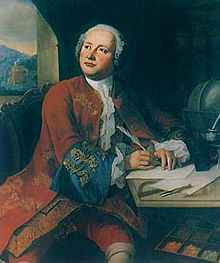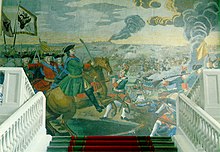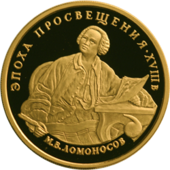Mikhail Wassiljewitsch Lomonossow
Mikhail Lomonosov ( Russian Михаил Васильевич Ломоносов , scientific. Transliteration Mikhail Vasil'evič Lomonoso v * 8; jul. / 19th November 1711 greg. In Mischaninskaja , Archangelgorod Governorate ; † 4 jul. / 15. April 1765 greg. In Saint Petersburg ) was a Russian scientist, poet, and reformer of the Russian language . He is considered a universal scholar during the Enlightenment .
Life

Lomonosov was born in 1711 into a farming family in the far north of Russia. As a boy he learned navigation and meteorology, but also acquired basic knowledge of Russian grammar . His thirst for knowledge was so pronounced that, against his father's will, he left the family and walked 1000 kilometers to Moscow to begin studying at the Spiritual Academy . Four years later he was sent to the Academy of Sciences in St. Petersburg together with some fellow students .
In 1736 he continued his studies in Germany at the University of Marburg (especially with the philosopher Christian Wolff ) in the subjects philosophy , mathematics , chemistry and physics and from 1739 to 1740 in the Freiberg laboratory of Johann Friedrich Henckel in mineralogy , mining and metallurgy. In Freiberg he also dealt intensively with literature . In 1740 he returned to Marburg, where he married the daughter of his landlady.
In 1741 he traveled to St. Petersburg to write his doctoral thesis with Georg Wolfgang Krafft . Two years later he was followed by his wife Elisabeth-Christina with their child. From 1745 he taught as a professor of chemistry in a teaching and research laboratory set up by him, but was also very productive as a poet. In 1750, Empress Elisabeth and the poet Trediakowski asked him to compose plays for the new National Theater, which he did with great success.
In 1754/1755 he worked with the active support of the Empress's favorite , Ivan Ivanovich Shuvalov , in founding the Moscow State University, the Lomonosov University named after him . In 1760 he became director of the University of the St. Petersburg Academy of Sciences. He died in St. Petersburg at the age of 53.
Services

Lomonossow is considered a polymath and the founder of Russian science, in particular as a co-founder of the sciences metallurgy , geology and meteorology , geography and cartography , but also the history of Russia. At the time, science in Russia was still the domain of foreign experts, especially Germans and French. Alexander Pushkin said of Lomonosov that not only did he create the first university in Russia, but he himself was a whole university. Many scientific pioneering achievements in numerous areas are associated with his name:
- Lomonosov contradicted the - at the time widely accepted - phlogiston theory . In 1748 he postulated the principle of mass conservation in chemical processes, which was formulated by Lavoisier in 1789 . Therefore, the law of conservation of mass is also known as the "Lomonossow-Lavoisier law".
- He was a proponent of the atomistic theory and prepared the kinetic gas theory in concrete terms: According to Lomonossow, heat is a form of movement of the smallest particles.
- In 1748 he developed a mechanical gravitation explanation .
- He determined the freezing point of mercury .
- He assumed that light spreads in waves.
- During the transit of Venus in 1761, he observed a narrow ring of light ( Lomonossow effect ) around the planetary disk and derived the assumption that Venus had an atmosphere.
- He was the first to establish a connection between auroras and electrical charge in the earth's atmosphere.
- The Coriolis force was first described by Lomonosov in 1763.
Lomonosov was also the first to correctly explain the fatal nature of icebergs for ships around 1750 : Since the density of the ice is 0.92 g / cm³ (density of sea water 1.025 g / cm³), 90 percent of the volume of the icebergs must be below the Surface of the water. His studies in Germany and his German wife are probably the reason why the polymath anchored the word iceberg (Russian: Айсберг , transcribed Aisberg ) in the Russian language.
In 1763 he wrote the memorandum Brief description of various research trips on the northern seas and indication of a possible passage on the Siberian Ocean to the East Indies . He gave precise instructions on how to equip and conduct an expedition to explore this sea route, which he believed should lead directly across the North Pole . 1765, a month after Lomonosov's death, found these three ships, led by Vasily Chichagov place, but hit west of Spitsbergen on compact ice and had to turn back.
While still a student in Freiberg, Lomonossow developed a new meter for his poetry based on the ideas of the Russian poet Trediakowski . He propagated Russian as the language of instruction and wrote a Russian grammar in 1757 , with which the written Russian language was fundamentally reformed. This grammar is a combination of Church Slavonic and the colloquial Russian of that time. In 1760 he published the first history of Russia .
Working in accordance with the ideas of Tsar Peter , Lomonosov was undoubtedly the most important innovator of the educational system in the Russian Empire ; at the same time he was the first world-class Russian scientist.
He also took care of the revival of Russian mosaic art . He founded a mosaic and stained glass factory in what is now Lomonossow (formerly: Oranienbaum) near St. Petersburg.
Honors
Namesake
The following were named after Lomonosov:
- the "Lomonossow-Lavoisier law" ( conservation of mass )
- the Lomonosov University Moscow
- the Lomonosov Gold Medal for outstanding achievement in science is, from a year since 1959, Russian Academy of Sciences awarded
- an order by the Academy of questions of law, defense and security of the Russian Federation awards
- the Lomonosov Bridge in St. Petersburg
- a Russian research vessel operated from 1957 to 1999
- the Russian, mobile (floating) nuclear power plant " Academician Lomonosov " to supply Pewek in the Chukchi Autonomous Okrug .
in geography:
- the city of Lomonossow near Saint Petersburg
- the village of Lomonossovo , his birthplace
- the Lomonossow Mountains in the East Antarctic Queen Maud Land
- the Lomonosov Ridge in the Arctic Ocean
- the Lomonosov Current in the Atlantic
- a volcanic group on the Kuril island of Paramushir
in astronomy:
- the Lomonosov Effect
- the asteroid (1379) Lomonosova
- a crater on the moon
- a crater on Mars
in space travel:
- the gamma-ray telescope Mikhailo Lomonosov , the 2016 from Vostochny Cosmodrome launched
Coins
275th Birthday Lomonosov 1986, a Soviet 1- rubles - commemorative coin of copper-nickel coined. In 1992 a Russian gold coin was minted with a face value of 100 rubles ( fineness 15.55 grams of gold, 5700 copies).
Works
- Первые основания металлургии или рудных дел. (First foundations of metallurgy or metallurgy), St. Petersburg 1763.
- Articles: О слоях земных. (About the strata of the earth), Зрелище природы и художеств. (The image of nature and art), Слово о рождении металлов от трясения земли. (Talk about the birth of metals through earthquakes), publ. in vol. V of Lomonosov's collected works (Полное собрание сочинений в 11 томах / Collected Works, Moscow & Leningrad 1950–1959).
- Cобрание сочинений (Collected Works), 8 volumes, Moscow, Leningrad 1934 to 1948
- Полное собрание сочинений / Polnoje sobranije sochinenij. (Collected Works), Sergei Iwanowitsch Wawilow (Ed.), 10 volumes, Moscow & Leningrad 1950–1959. Volume 11, Nauka 1983
- Mikhail Vasil'evich Lomonosov on the Corpuscular Theory , Translator and Introduction Henry M. Leicester , Harvard UP 1970
- Physico-chemical treatises by MW Lomonosov 1741-1752 . Edited by BN Menschutkin and Max Speter. Ostwald's classic 178, Leipzig: Engelmann 1910
- Selected writings in two volumes. Volume 1: Natural Sciences. Volume 2: History, Linguistics and Others. Academy, Berlin 1961.
- A chronological abridgment of the russian history. Translated into English and updated by Georg Forster . Series: Print Editions. Gale Ecco, Independence, KY 2010, ISBN 1-171-48444-5 .
- Michail Vasil'evic Lomonosov: Writings on geology and mining and metallurgy (1742–1765). Edited and commented by Friedrich Naumann. Verlag De Gruyter 2017. ISBN 978-3-11-042720-2 .
literature
- BM Kedrov: Lomonosov, Mikhail Vasilievich . In: Charles Coulston Gillispie (Ed.): Dictionary of Scientific Biography . tape 8 : Jonathan Homer Lane - Pierre Joseph Macquer . Charles Scribner's Sons, New York 1973, p. 467-472 .
- Mikhail W. Lomonosov 1711-1765. Mediator between East and West (= writings of the Hessian State Archive Marburg , Volume 6). Marburg 1990, ISBN 3-88964-149-0 .
- Peter Hoffmann: Michail Vasil'evič Lomonosov (1711–1765). An Encyclopedist in the Age of Enlightenment. Lang, Frankfurt am Main [a. a.] 2011, ISBN 978-3-631-61797-7 .
- Boris N. Menshutkin: Russia's Lomonosov, Chemist Courtier, Physicist Poet , Princeton: Princeton University Press 1952
- Friedrich Naumann: Michael Lomonossow's path to science (also Russian: Путь Михаила Васильевича Ломоносова в науку ). In: MW Lomonossow in Freiberg. Ed. on the occasion of the inauguration of the Lomonossow House in Freiberg Fischerstrasse on February 7, 2014. Freiberg 2014, pp. 3–48.
- Friedrich Naumann: Michail Vasil'evič Lomonosov's contribution to the development of geological sciences in Russia. In: Acamonta - special supplement. Extra edition of the magazine for friends and sponsors of the TU Bergakademie Freiberg. 23rd year 2016, pp. 1–16.
- Vladimir Shiltsev: Mikhail Lomonosov and the dawn of Russian science , Physics Today, Volume 65, February 2012, pp. 40-46
- Steven Usitalo: The Invention of Mikhail Lomonosov. A russian national myth , Boston: Academic Studies Press 2013
- Robert Crease, Vladimir Shiltsev: Mikhail Lomonosov (1711–1765): Scientist in politically turbulent times. In: Il Nuovo Saggiatore, Vol. 33, No. 5–6 (2017), pp. 41–54.
On Lomonosov and Germany:
- BN Menshutkin: Lomonosov in Marburg. Translated and compiled by Tatjana Högy-Lanko. In: alma mater philippina. Winter semester 1966/1967, pp. 15–20.
- Peter Scheibert: Lomonosov, Christian Wolff and the University of Marburg. In: Academia Marburgensis. Vol. 1: Contributions to the history of the Philipps University of Marburg. For the Department of History, ed. by W. Heinemeyer, Th. Klein, H. Seier. Marburg 1977, pp. 231-240.
- Markus Bauer: Passage Marburg. Excerpts from twenty-four life paths. With contributions by Ullrich Amlung and Rolf Bulang. Jonas, Marburg 1994, ISBN 3-89445-181-5 (therein: Michail Vasilevic Lomonosov, pp. 81-89).
- Traces of Marburg in the work of Michail Vasil'evič Lomonosov. In: Inge Auerbach: The Hessian lion and the Russian bear. Hessen-Kassel and Russia from the 16th to the 20th century; Exhibition by the Hessian State Archives in Marburg from September 22, 2003 to the end of February 2004, Hessisches Staatsarchiv, Marburg 2003, ISBN 3-88964-190-3 , pp. 72–90.
- Norbert Nail: Russi intra muros: Students from St. Petersburg 1736–1739 with Christian Wolff in Marburg. On the 300th birthday of the polymath Mikhail Vasil'evič Lomonosov on November 19, 2011. In: Studenten-Kurier. 1/2012, pp. 15-19.
- Konstantin Filippov and Liubov Grigorieva (St. Petersburg): Michail Lomonossov and the German language and culture in the XVIII. Century - A report on current research projects about a Russian polymath. In: Language & Languages. 45. 2013, pp. 1-16.
- Friedrich Naumann: The Lomonossow House and its history (also Russian: «Дом Ломоносова» и его история ). In: MW Lomonossow in Freiberg. Ed. on the occasion of the inauguration of the Lomonossow House in Freiberg Fischerstraße on February 7, 2014. Freiberg 2014, pp. 49–61.
- Robert Crease / Vladimir Shiltsev: Fueling Peter's Mill: Mikhail Lomonosov's Educational Training in Russia and Germany, 1731 - 1741. In: Physics in Perspective, Vol. 20, Issue 3, September 2018, pp. 272-304.
Web links
- Literature by and about Michail Wassiljewitsch Lomonossow in the catalog of the German National Library
- Illustrated chronology of Lomonosov's life
- Lomonosov's entry in the Marburg university register of November 17, 1736
- Lomonosov's passport dated May 13, 1741
Individual evidence
- ^ Conrad Grau : Lomonosov, Schlözer, Pallas: German-Russian scientific relations in the 18th century.
- ^ Karl H. Salzmann: The fight for the North Pole , Part 1: From the beginnings to the year 1882 (= Die Kosmos-Bibliothek. Volume 200), Stuttgart 1958, pp. 29–41.
- ^ First T. Snelling, London 1767. For the definition of the translator, see the note in his lemma
| personal data | |
|---|---|
| SURNAME | Lomonossow, Michail Wassiljewitsch |
| ALTERNATIVE NAMES | Lomonosov, Michail Vasil'evič (scientific transliteration); Михаи́л Васи́льевич Ломоно́сов (Russian) |
| BRIEF DESCRIPTION | Russian polymath, writer, linguist and historian, chemist and astronomer |
| DATE OF BIRTH | November 19, 1711 |
| PLACE OF BIRTH | Mishaninskaya , Archangelgorod Governorate |
| DATE OF DEATH | April 15, 1765 |
| Place of death | St. Petersburg |




